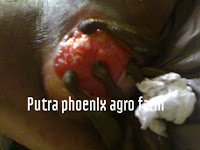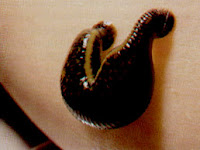
The animals should be applied in adequate numbers to the general area of maximal congestion. One (1) or two (2) leeches may be sufficient to treat the skin of a partially degloved or replanted finger, whereas a large flap may require 6 or more depending on initial clinical response. The head (or biting end) of the animal can be recognized by its searching movements, while the tail end is used mostly as a sucker for attachment.
1. Clean patient's skin thoroughly with soap and water to remove all substances with strong odor or taste such as traces of operative prep fluids or saline. Rinse cleansed areas with distilled, non-chlorinated or bottled water.
2. Recommended method for applying leeches:
Remove the plunger from a 5 cc plastic syringe and place the leech in the barrel of the syringe. Invert the barrel, placing the open end on the wound site, where you want the leech to attach. Once feeding commences, remove the syringe.
3. To prevent leech wandering, form a barrier by cutting a 1 cm hole in the middle of a dampened gauze square and locating the hole in close contact with the area to be treated.
4. Steer the leech's head to the area to be treated. Attachment generally occurs quickly;
however, if the leech is reluctant to bite, make a small needle prick on the skin to produce a tiny droplet of blood (which should result in enthusiastic attachment) or try another leech. Sugar or other sweet substances are not necessary. It should be noted that persistent resistance to feeding is often indicative of poor arterial supply.
5. Once the leech is attached, it will likely remain safely in place until fully distended. The gauze square can be removed and used elsewhere without disturbing the animal;however, it is important that the site be checked continuously to insure that the leech hasn't moved.
6. When the leech has finished its meal, usually within 45 minutes, it will detach itself from the bite site.
EQUIPMENT NEEDED TO APPLY LEECHES
Jar of leeches in distilled, non-chlorinated or bottled water containing HIRUDO salt.
Container with a small amount of alcohol for placing leeches after they have been used.
NOTE: To prevent cross contamination, used leeches must never be put with unused leeches.
Disposable bottle of sterile water.
Packet of gauze swabs.
Scissors and non-toothed forceps.
Small "Op-Site" dressing (optional).
5cc plastic syringe.
DISPOSAL OF LEECHES AFTER USE
Leeches which have been used on a patient should be disposed of by placing in a container of 70% alcohol for 5 minutes, then disposed of just as other infectious waste is disposed of.
Return unused leeches to the pharmacy in distilled, non-chlorinated or bottled water containing HIRUDO salt.
IMPORTANT WARNING:
NEVER REUSE a leech and NEVER RETURN a used leech to the pharmacy.
As with a dirty needle, failure to comply with this warning could result in transmittal of serious infectious diseases.















